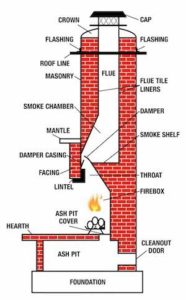Anatomy of Your Chimney (And Common Chimney Problems)
Your chimney may be the biggest system in your home besides the central air and heating unit and there’s a lot that can go wrong with it. Because it’s so big and can cause big problems for your home, it’s important to understand just what makes up the chimney system, how it works, and how it can go wrong.
 Parts of the Chimney
Parts of the Chimney
From bottom to top, there are many parts and materials that make up a fireplace and chimney system. The terms ‘fireplace’ and ‘chimney’ are often used interchangeably, and they work together to get the job done. What we know as the fireplace is actually called the firebox, and what we know as the chimney is actually the flue. These are only two parts of a very large system that must be built and maintained properly. Only then will the system work efficiently and safely.
Foundation – Just as the house itself sits on a foundation that holds it up and prevents settlement and shifting as seasons and weather change the soil, the chimney requires a foundation. Oftentimes this foundation is built when the home is built, but not always.
Ash Dump – Some, but not all, chimneys have an ash dump. This is a space beneath the firebox where ashes can be pushed and stored to cool and collect over time. A chimney sweep can remove these ashes as needed through a cleanout door near the foundation—a service that usually isn’t required for several years.
Hearth – The hearth is the floor of the firebox which usually extends from the back of the fireplace out into the room a bit and is made of a particular firebrick and refractory mortar that protects against heat transfer from the fire.
Firebox – The space where the fire sits and burns is called the firebox. It endures the highest temperatures for the longest periods but receives the least attention. The firebox is constructed of firebricks and refractory mortar.
Damper – The damper is a mechanism, usually made of metal, installed at the top of the firebox and opens and closes the flue opening. When the damper is closed, very little air moves through the chimney system. When the flue is open, air flows freely.
Smoke Chamber – The space above the firebox is called the smoke chamber—so named because this is where the particles and gases mingle with the heat to rise up the chimney. It is shaped like an inverted funnel to direct smoke upward and into the flue. Beneath the smoke chamber, there is a shelf (called the smoke shelf) designed to prevent smoke from falling back into the firebox and into the home. The walls of the smoke chamber should be at certain angles and smooth.
Flue – The flue is the interior vent by which smoke and gases travel out of the home. The surface of the flue should be covered with a liner that keeps heat and corrosive chemicals from damaging or moving through the masonry and gives it a seamless, smooth surface for optimum airflow.
Masonry Crown – At the top of the chimney there is a ceiling that extends from the flue opening to the edge of the chimney. The crown is made out of durable material that can withstand harsh temperatures, sunlight, and precipitation. It is also made at a slant so that water runs away from the flow and onto a drip edge, where it drips down onto the flashing at the roof instead of running down the masonry.
Chimney Cap – The chimney cap is the roof of the chimney system. It keeps water, animals, wind, and weather out. The cap is necessary to prevent chimney water damage and animal intrusion. It is often made of copper or stainless steel.
Common Chimney Problems
Even a well-constructed chimney can become damaged over time—especially through particularly rough winters or when subjected to coastal air and moisture.
- Spalling masonry can be particularly devastating to chimneys that stand in coastal regions. This is when the mortar cracks and falls away, causing bricks to loosen and take on water.
- Leaky chimneys can lead to damaged parts of the chimney, but also water damage throughout the house. A chimney leak can occur in any season and cause damage year-round.
- Smoky fireplaces are usually caused by an obstruction, draft issue, or even the wrong firewood being burned in the fireplace! A smoky fireplace doesn’t always require a repair but should always be troubleshot and a professional should be called if the problem persists.
- Liner damage is most often due to an old clay tile liner becoming worn out and breaking apart. You might find pieces of clay tile in your firebox or notice problems like masonry that is hot to the touch. Liner damage can also be caused by a dirty flue or a flue fire.
Whether your system is old or new, whether you have a fireplace, a stove, or an insert, whether you burn wood, pellets, or gas, your chimney is important. It can be a great asset, but can also be very dangerous. Make sure you know the ins and outs of chimney function and maintenance. Make sure your chimney system is safe and efficient. It will work better and for longer.
Call and schedule services with Billy Sweet Chimney Sweep today by calling 617-469-4528
The post Anatomy of Your Chimney (And Common Chimney Problems) appeared first on Billy Sweet Chimney Sweep.